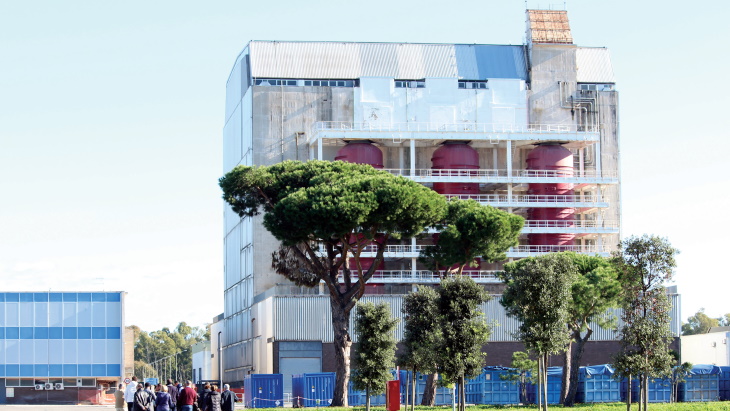
Whilst in operation, the steam generators (also referred to as boilers) - positioned outside the reactor building - allowed the heat to be transferred from carbon dioxide to water, thus producing the steam needed to drive the turbines and produce electricity.
Sogin described the dismantling of the steam generators as "a particularly complex activity because it involves components positioned at high altitude of large dimensions". Each one is 24 metres high with a diameter of 6 metres, with a combined weight of 3700 tonnes.
"Work is currently under way to build the confinement structures that will allow the areas affected by the boiler cutting and material handling activities to be isolated and kept safe from the external environment for the entire duration of the operations," Sogin said.
The project involves the subsequent sectioning of each boiler into nine cylindrical parts, each weighing approximately 90 tonnes, proceeding progressively from top to bottom. The technique adopted will be diamond wire-cutting, which simultaneously allows the internal components of the steam generator to be sectioned (tie rods, spacers, brackets, sheets, etc).
The cylindrical portions will be lowered to the ground using a special crane and then transferred to the Materials Treatment Station, which has already been built, where the tube bundles will be removed, the external casing will be cut into smaller parts and decontaminated with high-pressure water. Most of the operations will be carried out using high-tech robotic systems.
The metallic materials resulting from cutting the casing will be released and sent for recycling, while the tube bundles will be treated by melting by a qualified operator, in line with Sogin's circular economy strategy based on minimising radioactive waste.
Italy's Ministry of Economic Development issued a decree in 2020 authorising Sogin to begin the initial phase of decommissioning the Latina plant. The main activities envisaged during this initial phase concern the dismantling of the six boilers and the lowering of the reactor building height from 53 to 38 metres. Buildings and auxiliary systems will also be dismantled. These operations are in addition to those already carried out or in progress at the plant.
By the end of this phase, all previous radioactive wastes generated through the operation of the plant or those produced by the dismantling of structures, systems and plant components will be stored safely at the site. These wastes will be stored both in a new temporary storage facility and in some specifically adapted reactor building premises. This initial phase of decommissioning the Latina plant is expected to be completed in 2027 and to cost EUR270 million (USD284 million).
With the availability of a planned national repository, it will be possible to start the second and final phase of the decommissioning of the plant with the dismantling of the graphite gas reactor. Once all the radioactive waste has been transferred to the repository and the temporary storage facilities demolished, the site will be released, without radiological restrictions, and returned to the community for its reuse.